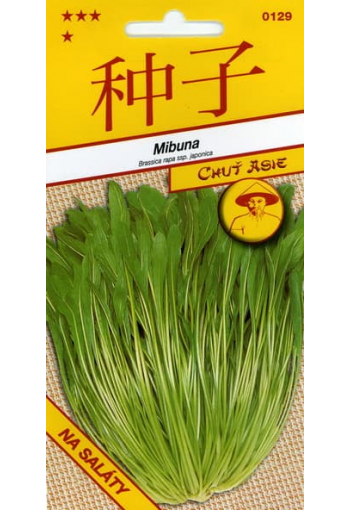Your shopping cart is empty!
Japanese sheet cabbage mibuna "Green Spray" F1 (green salad Kyoto)
Brassica rapa ssp. japonica
Discount vegetable seeds (shelf life 12.2023)
1.35€ 2.25€
Ex Tax: 1.11€
Ex Tax: 1.11€
Japanese leafy cabbage "Mibuna" (Kyoto green salad) - Brassica rapa ssp. nipponica.
Easy to grow and fast growing salad culture. Very cold hardy.
The period from full germination to the beginning of technical ripeness is 60-70 days. Contains biologically active substances: carotene, vitamins C, B1, B2, PP, potassium, calcium, phosphorus, iron salts. Forms a horizontal or slightly raised rosette of 44-60 leaves, 37-41 cm high, 64-75 cm in diameter. Leaves are green, lyre-pinnately-lobed, smooth or slightly wrinkled, incised along the edge. The petiole is white. The mass of one plant is 1.0-1.7 kg.
Japanese cabbage seeds are rather small, dark gray, slightly larger than a poppy seed.
1.0 g = 500 seeds.
The recommended shelf life of seeds is 3 years.
The optimum sowing depth is 0.5 cm.
Good taste. The yield of leaves with petioles is 5.0-6.5 kg / sq. m.
Plants are unpretentious, relatively heat and cold resistant. After cutting, young leaves grow back, which makes it possible to receive products throughout the entire summer-autumn period. The variety is resistant to flowering.
The value of the variety: high yield, resistance to adverse environmental conditions, long period of economic validity. Grown in open or protected ground from early spring to late autumn, sowing it at several times. To obtain early production, seedlings are sown in March and early April. When grown outdoors, the planting pattern is 30 x 50 cm, in greenhouses - 20 x 15-20 cm. The optimum temperature for growth and development is + 20 ° C. Recommended for vitamin salads.
Easy to grow and fast growing salad culture. Very cold hardy.
The period from full germination to the beginning of technical ripeness is 60-70 days. Contains biologically active substances: carotene, vitamins C, B1, B2, PP, potassium, calcium, phosphorus, iron salts. Forms a horizontal or slightly raised rosette of 44-60 leaves, 37-41 cm high, 64-75 cm in diameter. Leaves are green, lyre-pinnately-lobed, smooth or slightly wrinkled, incised along the edge. The petiole is white. The mass of one plant is 1.0-1.7 kg.
Japanese cabbage seeds are rather small, dark gray, slightly larger than a poppy seed.
1.0 g = 500 seeds.
The recommended shelf life of seeds is 3 years.
The optimum sowing depth is 0.5 cm.
Good taste. The yield of leaves with petioles is 5.0-6.5 kg / sq. m.
Plants are unpretentious, relatively heat and cold resistant. After cutting, young leaves grow back, which makes it possible to receive products throughout the entire summer-autumn period. The variety is resistant to flowering.
The value of the variety: high yield, resistance to adverse environmental conditions, long period of economic validity. Grown in open or protected ground from early spring to late autumn, sowing it at several times. To obtain early production, seedlings are sown in March and early April. When grown outdoors, the planting pattern is 30 x 50 cm, in greenhouses - 20 x 15-20 cm. The optimum temperature for growth and development is + 20 ° C. Recommended for vitamin salads.
Eng.: Japanese sheet cabbage. Suom.: Japaninsinappi, Mibuna-ryhmä. Sven.: Mibunakål, Japansk kålkål. Bot. syn: Brassica rapa ssp. nipposinica var. linearifolia.











